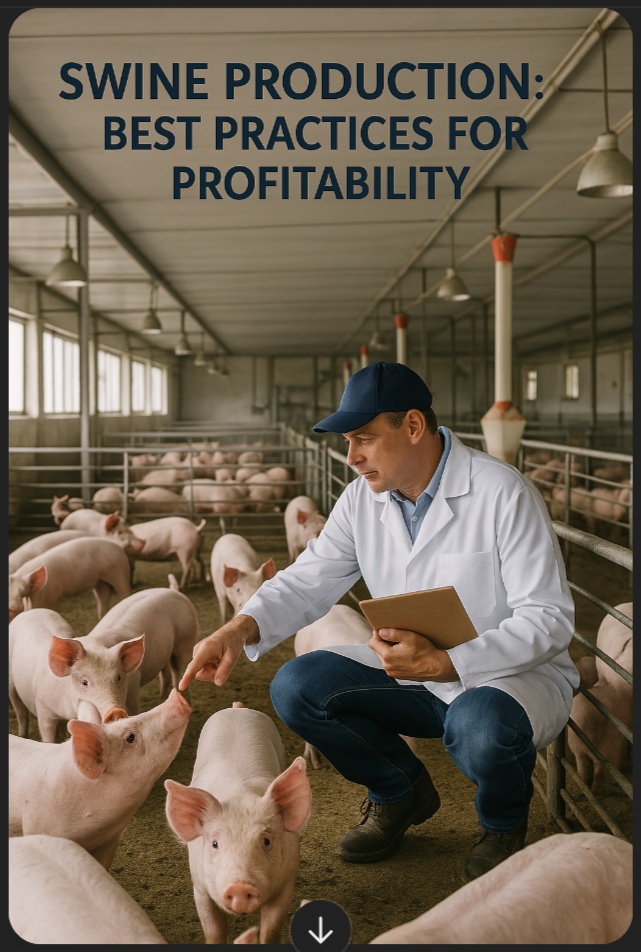Swine production is a lucrative agricultural enterprise that provides pork, a key protein source worldwide. To achieve maximum profitability, farmers must adopt best management practices covering genetics, nutrition, housing, health, and marketing. This article explores essential strategies for efficient and profitable swine production.
Breeding and Genetics
Click HERE to join our WhatsApp group
Genetics play a crucial role in determining the growth rate, feed efficiency, reproductive performance, and meat quality of pigs.
1. Selection of Breeding Stock
Choose breeds with desirable traits, such as fast growth, disease resistance, and high fertility.
Common commercial breeds include:
Large White: Fast growth and excellent carcass quality.
Duroc: High feed efficiency and marbling in meat.
Landrace: Exceptional reproductive ability and mothering traits.
Hampshire: High-quality lean meat production.
Source breeding stock from reputable suppliers.
2. Artificial Insemination (AI)
AI allows access to superior genetics without the cost of maintaining boars.
Improves litter uniformity and genetic progress.
READ ALSO: Lucrative Business Ideas In Poultry Farming Industry
3. Reproductive Management
Maintain a breeding schedule for optimal sow productivity.
Estrus detection and proper timing of mating ensure high conception rates.
Sows should produce 2.2 to 2.5 litters per year for profitability.
Nutrition and Feeding Management

Feed accounts for the largest portion of production costs. Providing a balanced diet is crucial for maximizing growth and reproduction.
1. Nutrient Requirements
Energy Sources: Maize, wheat, sorghum, and cassava provide energy.
Protein Sources: Soybean meal, fish meal, and groundnut cake support muscle growth.
Vitamins and Minerals: Ensure proper bone development and immune function.
Fiber and Additives: Fiber improves digestion, while probiotics enhance gut health.
READ ALSO: Advantages and disadvantages of common chicken drinkers
2. Feeding Strategies
Creep Feeding: Introduce solid feed to piglets at 7-10 days of age.
Phase Feeding: Adjust diets based on growth stages:
Starter (weaning to 25 kg)
Grower (25–50 kg)
Finisher (50 kg to market weight)
Precision Feeding: Reduce waste by adjusting rations based on growth rates.
3. Water Management
Provide clean and fresh water at all times.
Automatic drinkers improve water availability and hygiene.
Housing and Farm Management
READ ALSO: Gangrenous Dermatitis in Poultry
Proper housing ensures animal comfort, health, and productivity.
1. Housing Design
Ensure adequate space per pig:
Weaners: 0.3–0.5 m² per pig
Growers: 0.75–1.0 m² per pig
Finishers: 1.2–1.5 m² per pig
Use well-ventilated and well-drained pens.
Maintain separate areas for breeding, gestation, farrowing, weaning, and fattening.
2. Temperature and Ventilation
Piglets require heating (30-32°C), while finishing pigs thrive at 18-24°C.
Use fans, cooling pads, or sprinklers in hot climates.
Proper ventilation prevents respiratory diseases.
3. Waste Management
Efficient manure disposal reduces odor and disease risk.
Convert waste into biogas or organic fertilizer.
Health Management and Disease Prevention
READ ALSO: Floor Space Requirements For Broilers & Layers
Maintaining herd health is essential for reducing mortality and improving growth rates.
1. Biosecurity Measures
Limit farm access to essential personnel only.
Quarantine new pigs before introduction.
Disinfect housing, equipment, and vehicles regularly.
2. Common Swine Diseases and Control
African Swine Fever (ASF): Highly contagious, no cure; strict biosecurity needed.
Porcine Reproductive and Respiratory Syndrome (PRRS): Vaccination and strict hygiene help control outbreaks.
Swine Dysentery: Prevent with proper sanitation and antibiotic treatment.
Foot and Mouth Disease: Vaccination and movement control prevent spread.
Internal and External Parasites: Deworming and proper sanitation are essential.
3. Vaccination and Medication
Implement a vaccination schedule for common diseases.
Routine deworming and vitamin supplementation enhance pig health.
Marketing and Economic Considerations
Profitability in swine production depends on efficient marketing strategies.
1. Market Research
Identify demand for pork in local and international markets.
Target high-value products such as organic pork or processed meat.
READ ALSO: INTESTINAL WORMS IN POULTRY (1)
2. Cost Management
Reduce feed costs by using alternative feed ingredients.
Optimize labor efficiency to reduce production costs.
3. Value Addition
Processing pork into sausages, bacon, or ham increases profitability.
Direct selling to consumers or restaurants fetches better prices.
Sustainability in Swine Production
Sustainable farming ensures long-term profitability and environmental conservation.
1. Alternative Feeds
Use agricultural by-products such as brewers’ grains and cassava peels.
2. Renewable Energy Use
Utilize biogas from pig manure for farm operations.
3. Agroforestry and Integrated Farming
Combine pig farming with crop production to recycle nutrients.
Conclusion
Adopting best practices in breeding, feeding, housing, health management, and marketing ensures a profitable and sustainable swine enterprise. Farmers must focus on efficiency, cost reduction, and disease prevention to maximize their return on investment. With proper planning and management, swine production can be a highly rewarding venture.
READ ALSO: Housing and Management Systems for Livestock and Poultry
Proper housing and management systems are crucial for ensuring the health, comfort, and productivity of livestock and poultry. Well-designed housing provides protection from harsh weather, predators, and diseases, while effective management practices ensure efficient production and profitability…
READ ALSO: Strategies to Ensure Adequate Water Supply for Livestock and Poultry
Water is a fundamental requirement for the health, productivity, and overall well-being of livestock and poultry. Animals need water for digestion, temperature regulation, nutrient transport, and metabolic functions. Ensuring a consistent and adequate water supply is essential, especially in areas prone to drought, extreme weather, or unreliable water sources. This article explores various…
Click HERE to join our WhatsApp group

